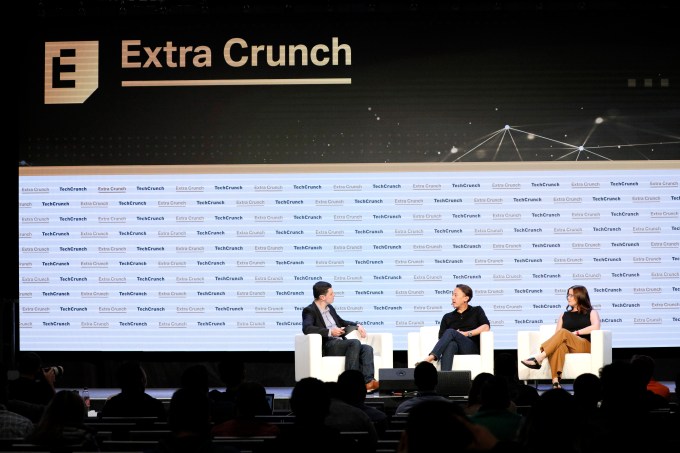Subscription has been all the rage in media circles as the industry searches for new, sustainable business models. We’ve seen companies from infrastructure plays like Substack and Pico to brand verticals like Holloway and The Athletic receive venture funding, all with the goal of changing the economics of news, information and entertainment.
Every day, I get the fortune of talking with founders about their startups and writing about them on TechCrunch, but I’ve also been something of an intrapreneur myself, building out product in the form of TechCrunch’s membership service Extra Crunch as EC’s executive editor over the past two years.
This month, I am transitioning to work on new projects at TechCrunch, and my co-editor Eric Eldon is now going to lead the charge on Extra Crunch as executive editor working in tandem with our new EC senior editor Walter Thompson.
So given the changing of the editorial guard, I wanted to write down some thoughts about editorial product strategy as well as some of the hard-won lessons learned about what worked and what didn’t in building a subscription product in today’s media environment.
The art of building an editorial product strategy within constraints
Before we get into some lessons though, I want to talk about product strategy a little bit. Every startup needs a product strategy, and Extra Crunch was no exception. The difference is that we are fundamentally an editorial product, which means that instead of transforming lines of codes into functional software, we take ideas, interviews, research, and analysis and transform them into articles and other media that users (hopefully!) want to pay for.
Product strategy involves devising a plan within constraints, and TechCrunch was no exception.
The first constraint was that we were not starting from scratch. Unlike a startup, TechCrunch has been here for years and has a strong brand name in the startup community, millions of passionate readers, a successful advertising and events business, and an editorial org that knows how to be productive. We couldn’t just throw out the playbook that has worked for years in the pursuit of a new business model that was untested. And so from the beginning, we had to have an attitude of evolution rather than one of revolution.
Second, we had limited resources in terms of capital and talent. TechCrunch is not a venture-backed company with millions of dollars in funding waiting to be burned in our bank account. Instead, we are a successful, sustainable and sometimes ridiculously efficient media business owned by a telecom that rewards proven financial performance. So when we launched, I was the only dedicated editorial position for Extra Crunch, along with a smattering of freelancers. As we have proven our success since launch this past February, we have since expanded to three dedicated editorial positions for EC. Throughout, we’ve had to have a strategy that was careful about spending our resources.
Third, we had to design a strategy that encompassed the talents of our existing staff. TechCrunch has consistently avoided the “hire a bunch of people and then fire a bunch of people” waves that hit New York media companies again and again and again by relying on smart reporters who can adapt with the changing tides of media. Extra Crunch was no exception — we wanted to build a product that every one of our writers could contribute to.
Those were the constraints. On top of that, I had a couple of personal rules for the product.
First, I hate metered paywalls (i.e. any model that charges you after reading a set number of articles) with a fiery passion. It has never made sense to me that articles could be free for some people, paid for others, or that the article that tries to force a conversion could be a news brief and not one of the best articles a site has published. To optimize for conversions, you want to trigger a conversation around moving from free to paid at just the right time, and not because the article clock has ticked down to zero.
Second, I didn’t want any of our writers to be placed entirely behind the paywall. Everything in subscription (media or not) should be focused on guiding users through the conversion funnel. If a writer is entirely behind the paywall, how can anyone sample their work or start to engage with that voice?
Third and finally, we had to charge for the right kinds of content. People don’t pay for news. They don’t, they won’t, and every time we as an industry ask users to do so, we fail (minus maybe the NYT and WSJ). At TechCrunch, our startup news coverage drives a huge loyal following and is a major credibility point of pride for many early-stage founders. It’s not good business to put that core offering behind a paywall.
With all those constraints and rules in mind, what we ended up centering Extra Crunch on was solving the problems facing founders in building their startups. That included how to raise venture capital, recruit talent, grow, pay themselves, work with PR agencies, and much, much more. I was previously a VC, and so I essentially channeled all the questions my founders would ask me into articles that solved those problems. Since launch in February, we’ve published about 600 articles on these topics.
This approach has allowed us to maximize our existing audience, which already encompasses a large number of founders, designers, builders, and product managers, but also has allowed our writers to write to their strengths, building on their relationships to research and answer new questions.
The great news is that one of our core metrics — engaged reading time — has been very strong, averaging upwards of 5 to 10 minutes per piece depending on its length. Subscribers don’t just read, they read closely and deeply that is not typical of a web surfer stopping by the site for a few seconds.
Now, on to some lessons from this whole product launch and early-growth phase.
Mistake: setting the wrong expectations around content length
I really despise the terms “longform” and its diminutive cousin “shortform.” Articles should be exactly the right length — no longer and no shorter than what is necessary to communicate their ideas. Longform articles are not fundamentally better because they are longer, and in fact, can actually be a lot worse if they convey little with many words.
One of the biggest concerns I heard from TechCrunch writers early on was that they would have to leave their beats for weeks at a time in order to produce “in-depth” subscription content — code for really, really longform pieces.
This fear was exacerbated by a mistake I made right at our launch: we published the Patreon EC-1 package as the very first set of articles on Extra Crunch. Eric Peckham, our media columnist, wrote nearly 24,000 words on the company after conducting many interviews with the startup’s leadership and others in the music and maker industries. A lot of folks on our staff looked at the gargantuan work involved in that package and basically thought “I just don’t have the time to do that” on top of all of their other duties.
Over time, we learned through data that article length has almost no correlation with the number of conversions or the readership of an article. People pay for short articles, long articles and everything in between so long as it meets their needs. That’s a major reason why we don’t have word counts or reading times listed on our content.
Frankly, it took months to emphasize that EC was a change in tone and focus in reporting, rather than just a refuge for extremely long pieces of content. A big part of that was trying to make a splash from day one, rather than just diving right into our day-to-day editorial. I would not take that approach a second time through.
Do: be very mindful of the number of premium articles

Beyond just content length, there was a huge debate early on around how many articles we should publish on EC each day. The obvious argument is essentially “the more the merrier,” since more articles get more readership and therefore more chances to convert users. Of course, there are real constraints, and writing more articles for EC meant drawing resources away from our news coverage on TechCrunch.
The approach that we’ve taken is to keep EC frequent but not overpowering. I have always believed that our core users are extremely busy and overwhelmed by the amount of media they feel a need to consume. So I have pushed hard, in line with my thesis around brainjunk, to try to force us to write a very small number of high-quality articles and simply ask that people pay for them. We ended up targeting about 2-3 articles per weekday, or roughly 5% of TechCrunch’s total volume each day.
Do: Completely ignore users who compare you to Netflix
I have talked a lot about subscription hell, or the sheer number of subscriptions that consumers are being asked to sign up for these days (and that was back in 2018 — hello Disney+!). Hundreds of millions of consumers subscribe to Netflix, or Spotify, or Amazon Prime, or Apple Music, and so invariably, you start to see comparisons of different subscription offerings against each other.
Here’s the thing: Extra Crunch (and really any niche media subscription publication) is not Netflix. We aren’t a general video entertainment service. Instead, we are a service that tries to help founders, builders, and other tech leaders do better in their jobs every single day. That’s just a completely different value proposition.
So when users start to do the comparisons with us (“you’re priced the same as Netflix!!!1”), I flat out ignore them (well, I try to educate, but you get my drift). If a user doesn’t find value in the product, then move on and find the users who do.
Mistake: ‘misunderestimating’ the timeline of product launches
Editorial is our product, but of course, we still have software that drives EC.
Unlike a startup that can just build a stack from scratch, we have software — sometimes really legacy software — that powers our platform. The approach we took on product had to take these constraints into account.
Our product team always gives reasonable timelines, but I have been guilty of just assuming that things will work faster than expected (and yes, I have a technical background and should know better). Unfortunately, I massively underestimated engineering timelines, and that has made communicating with our editorial staff and our readers challenging.

Pocket watch silver swinging on a chain black background to hypnotize
I’ll give two choice examples. First, identity is just tough for us. We have multiple internal identity providers thanks to a legacy of mergers and acquisitions, plus on top of that, we have identity in the context of our content management system as well as our paywall provider. It is a sheer programmatic chore to keep identity information synced across all of these databases, not to mention that each of these identity layers incorporates new changes that break the existing flows. If I had a magic wand, I would create the ultimate “one true identity source of truth.” But I don’t have a magic wand, and instead have code that needs to continue to function.
Second, launching internationally is extremely challenging for us as well. Extra Crunch is available in a handful of countries, but launching elsewhere can require dozens of people to work together to handle tax, accounting, legal, policy, and security reviews across multiple corporate entities and regions. We have thousands of users requesting access from dozens of other countries, but it just takes a lot of work to launch any specific country, making promising a timeline very hard.
The lesson for me here is to work with the timelines you are given, and realize that the world around subscription law is getting ever more complicated.
Do: give your writers huge room to experiment
We are blessed at TechCrunch to have a great editorial team, but as with any new editorial product, there is always a healthy fear of change.
One of the biggest challenges of launching a subscription media product within an existing brand is convincing writers to write for you. On a site where a top-trafficked article can get a million reads, it is hard to convince anyone to put their work behind a wall where only a few thousand people might read it (even if those readers are heavily engaged). Plus, some of our writers have been successfully producing content for a decade or more — some of our staff have literally written thousands of articles on TechCrunch. Any change to that formula is going to take time to be accepted.
On top of that, TechCrunch’s newsroom is very decentralized and bottoms-up. The reason we catch the next startup wave in a space is because our writers don’t have to go up and down the editor stack to get permission to chase a story or a trend. Instead, they can keep their ears to the ground and hunt for the best stories.
So we built structures to ensure that EC can be part of every staffer’s work when they are ready to engage with us. Every writer at TC has their own Slack channel that connects them to the EC editorial team and functions as a place to circulate ideas and get rapid feedback. As good ideas have worked, we’ve then circulated them to other writers as possible models for them to consider.
This approach has afforded us much more experimentation in the early phase of the product than if we had simply set out three buckets of content and demanded that everything fit perfectly inside of them.
Do: Integrate paid with the rest of the editorial product
Extra Crunch is a special, members-only place, but we also wanted to make sure that the product was integrated into everything else that we do. We took a couple of approaches here.
First, we integrated our content into other parts of TechCrunch. For example, Kate Clark and Alex Wilhelm host our VC-focused podcast Equity, which discusses the venture rounds of the week and the startups behind them. When we have published our in-depth EC-1 business analyses, we have also tried to do a special episode of Equity called an Equity Dive where we discussed some of the takeaways of the EC-1 piece for the Equity audience (for instance, here is one on Patreon). Those episodes are packed with interesting tidbits, and also act as marketing for EC.

Danny Crichton, Mailchimp Co-founder & CEO Ben Chestnut and Kabbage Co-Founder & President Kathryn Petralia speak onstage during TechCrunch Disrupt San Francisco 2019 (Photo by Kimberly White/Getty Images for TechCrunch)
Second, we created a whole “Extra Crunch Stage” at our flagship conference Disrupt, again focused on solving the challenges that founders face every day. Among the panels we hosted were how to build a billion dollar subscription business, how to get into YC, how to build a startup culture, how to iterate a product, and how to exit your startup. What was great was the balance between our news-breaking Main Stage and the more skills-orinted EC stage. Plus, we also had a special members lounge for EC subscribers at the event, which proved even more popular that I would have predicted (yes, members want to feel exclusive!)
Finally, we also offer EC members a discount on our events, which has driven more attention to our Sessions events and to TechCrunch Disrupt Berlin, where we will have another EC stage this coming December. We love it when members show up in person, and so we wanted to incentivize that as much as we could could. It’s a nice way to say thanks to our most enthusiastic customers.
Do: have a free newsletter for your paid content
This is one we accidentally stumbled upon but has worked really, really well. We have a free newsletter called the Extra Crunch Roundup (example issue) that summarizes the pieces we’ve published on EC.
Here is something crazy: we have about a 4:1 ratio of free users to paid users subscribing to the newsletter. In other words, roughly 80% of the users reading the subscription-focused newsletter don’t subscribe to Extra Crunch.
I can’t stress enough how useful this is. In some cases, these users don’t have access to EC because we haven’t launched in their country, or they haven’t made a purchase decision about us yet. By allowing them to stay tapped into our community, we keep them engaged and hopefully in the long run, turn them into customers.
Mistake: failing to fully integrate real-time analytics into editorial decision-making
Extra Crunch faces a typical business intelligence problem: our core user and analytics data is scattered across a number of data silos, and we don’t have a data lake (a term that, if used in an email sent to me, automatically sends the email to spam by the way). Like many smaller media companies, we lack the data science team and data pipeline engineers required to build out a full BI function.
I code, and I have been able to cobble together some Python scripts to pipeline some of our data into an Airtable so that we have at least decent visibility on what our readers like and what they don’t (in some cases involving manually scraping our own sites since some of our tools don’t have API access). But it doesn’t allow us to make real-time decisions about our content, and that acts as friction to delivering the best possible experience.
While analytics is obviously important for our business leaders, it’s really editorial that needs the data the most. As I was building out the editorial strategy, I would have put even more time into thinking through our analytics strategy to ensure we had the right feedback mechanisms in place from day one to do quality data analysis.
Focused, steady progress against the media maelstrom
It’s been exhilarating watching a product start on a whiteboard and now being enjoyed by paying customers.
Media, and particularly New York media, loves the ambitious editor that wants to shake things up and shoot for the stars with massive budgets and a huge vision. But the reality is that the gyrations in the media industry in Manhattan are entirely avoidable by focusing on users, getting the basics right, using feedback properly, and being sure to walk before you run.
TechCrunch has watched as new publications have jumped into covering the tech industry, old publications have withered and faded away, and every format of media has come and gone. What has ultimately worked for us is to stay true to our founding mission: to fairly cover the startup world and all of its facets. That’s why we’ve always been here, and if the data we have is any proof, a heck of a lot of people are willing to pay to ensure that focus continues for us. So to our early Extra Crunch members — thank you. And of course, the best is yet to come.

Source: Tech Crunch










